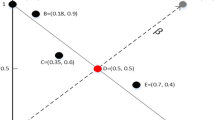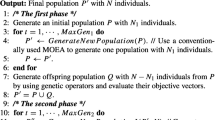Abstract
Most many-objective optimization algorithms focus on balancing convergence and diversity, instead of attaching importance to the contribution of the boundary solution. The boundary solution is beneficial for enhancing the PF coverage; therefore, we propose a many-objective evolutionary algorithm based on the corner solution and cosine distance (MaOEA-CSCD) to balance convergence and diversity, as well as protect the PF boundary. We set a corner solution archive to store the corner solutions and apply these corner solutions and cosine distance in the mating strategy to improve the quality of the parents to generate high-quality offspring. In environmental selection, a greedy strategy is applied to select the corner solution and the solution with better convergence to overcome the insufficient selection pressure while protecting the PF boundary and guaranteeing the search space. Then, a selection–deletion strategy is used to balance convergence and diversity, it first selects solutions based on the maximum cosine distance, and then considers replacement solutions based on convergence. The comparison of MaOEA-CSCD with six algorithms on 25 benchmark and three real-world optimization problems shows that it is competitive.









Similar content being viewed by others
References
Zhang M, Wang L, Li W, Hu B, Li D, Wu Q (2021) Many-objective evolutionary algorithm with adaptive reference vector. Inf Sci 563:70–90. https://doi.org/10.1016/j.ins.2021.01.015
Di Matteo M, Maier HR, Dandy GC (2019) Many-objective portfolio optimization approach for stormwater management project selection encouraging decision maker buy-in. Environ Model Softw 111:340–355. https://doi.org/10.1016/j.envsoft.2018.09.008
Xu J, Zhang Z, Hu Z, Du L, Cai X (2021) A many-objective optimized task allocation scheduling model in cloud computing. Appl Intell 51(6):3293–3310. https://doi.org/10.1007/s10489-020-01887-x
Hu Z, Wei Z, Sun H, Yang J, Wei L (2021) Optimization of metal rolling control using soft computing approaches: a review. Arch Comput Methods Eng 28(2):405–421. https://doi.org/10.1007/s11831-019-09380-6
Hu Z, Wei Z, Ma X, Sun H, Yang J (2020) Multi-parameter deep-perception and many-objective autonomous-control of rolling schedule on high speed cold tandem mill. ISA Transactions 102:193–207. https://doi.org/10.1016/j.isatra.2020.02.024
Liang Z, Luo T, Hu K, Ma X, Zhu Z (2020) An indicator-based many-objective evolutionary algorithm with boundary protection. IEEE Trans Cybern, p 1–14. https://doi.org/10.1109/TCYB.2019.2960302
Liu Y, Gong D, Sun J, Jin Y (2017) A many-objective evolutionary algorithm using a one-by-one selection strategy. IEEE Trans Cybern 47(9):2689–2702. https://doi.org/10.1109/TCYB.2016.2638902
Liu Y, Zhu N, Li K, Li M, Zheng J, Li K (2020) An angle dominance criterion for evolutionary many-objective optimization. Inf Sci 509:376–399. https://doi.org/10.1016/j.ins.2018.12.078
Li M, Yang S, Liu X (2014) Shift-based density estimation for pareto-based algorithms in many-objective optimization. IEEE Trans Evol Comput 18(3):348–365. https://doi.org/10.1109/TEVC.2013.2262178
Tian Y, Cheng R, Zhang X, Su Y, Jin Y (2018) A strengthened dominance relation considering convergence and diversity for evolutionary many-objective optimization. IEEE Trans Evol Comput 23 (2):331–345. https://doi.org/10.1109/TEVC.2018.2866854
Narukawa K (2013) Effect of dominance balance in many-objective optimization. in Evolutionary Multi-Criterion Optimization. Springer, Berlin, pp 276–290
Bader J, Zitzler E (2011) HypE: an algorithm for fast hypervolume-based many-objective optimization. Evol Comput 19:45–76. https://doi.org/10.1162/EVCO_a_00009
Shang K, Ishibuchi H (2020) A new hypervolume-based evolutionary algorithm for many-objective optimization. IEEE Trans Evol Comput 24(5):839–852. https://doi.org/10.1109/TEVC.2020.2964705
Jiang S, Zhang J, Ong Y-S, Zhang AN, Tan PS (2014) A simple and fast hypervolume indicator-based multiobjective evolutionary algorithm. IEEE Trans Cybern 45(10):2202–2213. https://doi.org/10.1109/TCYB.2014.2367526
Deb K, Mohan M, Mishra S (2005) Evaluating the -domination based multi-objective evolutionary algorithm for a quick computation of pareto-optimal solutions. Trans Cybern 13(4):501–525. https://doi.org/10.1162/106365605774666895
Brockhoff D, Zitzler E (2007) Improving hypervolume-based multiobjective evolutionary algorithms by using objective reduction methods. In: 2007 IEEE Congress on Evolutionary Computation. https://doi.org/10.1109/CEC.2007.4424730, pp 2086–2093
Sun Y, Yen GG, Yi Z (2018) IGD indicator-based evolutionary algorithm for many-objective optimization problems. IEEE Trans Evol Comput 23(2):173–187. https://doi.org/10.1109/TEVC.2018.2791283
Hernández Gómez R, Coello Coello CA (2015) Improved metaheuristic based on the R2 indicator for many-objective optimization. In: Proceedings of the 2015 annual conference on genetic and evolutionary computation. https://doi.org/10.1145/2739480.2754776, pp 679–686
Li F, Cheng R, Liu J, Jin Y (2018) A two-stage R2 indicator based evolutionary algorithm for many-objective optimization. Appl Soft Comput 67:245–260. https://doi.org/10.1016/j.asoc.2018.02.048
Jiao RLWBL (2020) A decomposition-based evolutionary algorithm with correlative selection mechanism for many-objective optimization. Evol Comput 29(3):1–36. https://doi.org/10.1162/evco_a_00279
Li Z, Lin K, Nouioua M, Jiang S, Gu Y (2019) DCDG-EA: Dynamic convergence–diversity guided evolutionary algorithm for many-objective optimization. Expert Systems with Applications 118:35–51. https://doi.org/10.1016/j.eswa.2018.09.025
Xiang Y, Zhou Y, Li M, Chen Z (2016) A vector angle-based evolutionary algorithm for unconstrained many-objective optimization. IEEE Trans Evol Comput 21(1):131–152. https://doi.org/10.1109/TEVC.2016.2587808
Pan C, Huang J, Hao J, Gong J (2020) Towards zero-shot learning generalization via a cosine distance loss. Neurocomputing 381:167–176. https://doi.org/10.1016/j.neucom.2019.11.011
Zitzler E, Laumanns M, Thiele L (2001) SPEA2: Improving the strength pareto evolutionary algorithm for multiobjective optimization. In: Evolutionary methods for design, optimization and control with applications to industrial problems. Proceedings of the EUROGEN’2001. Athens. Greece, September 19-21. https://doi.org/10.3929/ethz-a-004284029
Yuan J, Liu H-L, Gu F, Zhang Q, He Z (2021) Investigating the properties of indicators and an evolutionary many-objective algorithm using promising regions. IEEE Trans Evol Comput 25(1):75–86. https://doi.org/10.1109/TEVC.2020.2999100
Zhou J, Gao L, Li X, Zhang C, Hu C (2021) Hyperplane-driven and projection-assisted search for solving many-objective optimization problems. Inf Sci 574:394–412. https://doi.org/10.1016/j.ins.2021.05.080
Zhou J, Rao S, Gao L, Lu C, Zheng J, Chan FTS (2022) Self-regulated bi-partitioning evolution for many-objective optimization. Inf Sci 589:827–848. https://doi.org/10.1016/j.ins.2021.12.103
Singh HK, Isaacs A, Ray T (2011) A pareto corner search evolutionary algorithm and dimensionality reduction in many-objective optimization problems. IEEE Trans Evol Comput 15 (4):539–556. https://doi.org/10.1109/TEVC.2010.2093579
Wang H, Yao X (2014) Corner sort for pareto-based many-objective optimization. IEEE Trans Cybern 44(1):92–102. https://doi.org/10.1109/TCYB.2013.2247594
Deb K, Pratap A, Agarwal S, Meyarivan T (2002) A fast and elitist multiobjective genetic algorithm: NSGA-II. IEEE Trans Evol Comput 6(2):182–197. https://doi.org/10.1109/4235.996017
Zhou J, Yao X, Gao L, Hu C (2021) An indicator and adaptive region division based evolutionary algorithm for many-objective optimization. Appl Soft Comput 99:106872. https://doi.org/10.1016/j.asoc.2020.106872
Liang Z, Hu K, Ma X, Zhu Z (2021) A many-objective evolutionary algorithm based on a two-round selection strategy. IEEE Transactions on Cybernetics 51(3):1417–1429. https://doi.org/10.1109/TCYB.2019.2918087
Liang Z, Zeng J, Liu L, Zhu Z (2021) A many-objective optimization algorithm with mutation strategy based on variable classification and elite individual. Swarm Evol Comput 60:100769. https://doi.org/10.1016/j.swevo.2020.100769
Qiu W, Zhu J, Wu G, Fan M, Suganthan PN (2021) Evolutionary many-objective algorithm based on fractional dominance relation and improved objective space decomposition strategy. Swarm Evol Comput 60:100776. https://doi.org/10.1016/j.swevo.2020.100776
Xiong Z, Yang J, Hu Z, Zhao Z, Wang X (2021) Evolutionary many-objective optimization algorithm based on angle and clustering. Appl Intell 51(4):2045–2062. https://doi.org/10.1007/s10489-020-01874-2
Zhang P, Li J, Li T, Chen H (2020) A new many-objective evolutionary algorithm based on determinantal point processes. IEEE Trans Evol Comput 25(2):334–345. https://doi.org/10.1109/TEVC.2020.3035825
Deb K, Agrawal RB (1995) Simulated binary crossover for continuous search space. Complex Syst 9(2):115–148
Deb K, Goyal M (1996) A combined genetic adaptive search (geneAS) for engineering design. Computer Science and informatics 26:30–45
Su Y, Luo N, Lin Q, Li X (2022) Many-objective optimization by using an immune algorithm. Swarm Evol Comput 69:101026. https://doi.org/10.1016/j.swevo.2021.101026
Li M, Yao X (2019) Quality evaluation of solution sets in multiobjective optimisation: a survey. ACM Computing Surveys (CSUR) 52(2):1–38. https://doi.org/10.1145/3300148
Zitzler E, Thiele L, Laumanns M, Fonseca CM, Da Fonseca VG (2003) Performance assessment of multiobjective optimizers: An analysis and review. IEEE Trans Evol Comput 7(2):117–132. https://doi.org/10.1109/TEVC.2003.810758
Kung HT, Luccio F, Preparata FP (1975) On finding the maxima of a set of vectors. J. ACM 22(4):469–476. https://doi.org/10.1145/321906.321910
Jensen MT (2003) Reducing the run-time complexity of multiobjective EAs: The NSGA-II and other algorithms. IEEE Trans Evol Comput 7(5):503–515. https://doi.org/10.1109/TEVC.2003.817234
Deb K, Jain H (2013) An evolutionary many-objective optimization algorithm using reference-point-based nondominated sorting approach, part I: solving problems with box constraints. IEEE Trans Evol Comput 18(4):577–601. https://doi.org/10.1109/TEVC.2013.2281535
Li L, Yen GG, Sahoo A, Chang L, Gu T (2021) On the estimation of pareto front and dimensional similarity in many-objective evolutionary algorithm. Inf Sci 563:375–400. https://doi.org/10.1016/j.ins.2021.03.008
Deb K, Thiele L, Laumanns M, Zitzler E (2005) Scalable test problems for evolutionary multiobjective optimization. In: Evolutionary Multiobjective Optimization, p 105–145. https://doi.org/10.1007/1-84628-137-7_6
Ran Cheng YTXZSYYJXY, Li Miqing (2017) A benchmark test suite for evolutionary many-objective optimization. IEEE Trans Cybern 47:67–81. https://doi.org/10.1007/s40747-017-0039-7
Huband S, Hingston P, Barone L, While L (2006) A review of multiobjective test problems and a scalable test problem toolkit. IEEE Trans Evol Comput 10(5):477–506. https://doi.org/10.1109/TEVC.2005.861417
Tanabe R, Ishibuchi H (2020) An easy-to-use real-world multi-objective optimization problem suite. Appl Soft Comput 89:106078. https://doi.org/10.1016/j.asoc.2020.106078
Tian Y, Cheng R, Zhang X, Jin Y (2017) PlatEMO: A matlab platform for evolutionary multi-objective optimization. IEEE Comput Intell Mag 12(4):73–87. https://doi.org/10.1109/MCI.2017.2742868
Zhu Q, Lin Q, Li J, Coello Coello CA, Ming Z, Chen J, Zhang J (2021) An elite gene guided reproduction operator for many-objective optimization. IEEE Trans Cybern 51(2):765–778. https://doi.org/10.1109/TCYB.2019.2932451
Zou J, Liu J, Yang S, Zheng J (2021) A many-objective evolutionary algorithm based on rotation and decomposition. Swarm Evol Comput 60:100775. https://doi.org/10.1016/j.swevo.2020.100775
Yuan Y, Xu H, Wang B, Zhang B, Yao X (2016) Balancing convergence and diversity in decomposition-based many-objective optimizers. IEEE Trans Evol Comput 20(2):180–198. https://doi.org/10.1109/TEVC.2015.2443001
Jain H, Deb K (2014) An evolutionary many-objective optimization algorithm using reference-point based nondominated sorting approach, part II: Handling constraints and extending to an adaptive approach. IEEE Trans Evol Comput 18(4):602–622. https://doi.org/10.1109/TEVC.2013.2281534
Parsons MG, Scott RL (2004) Formulation of multicriterion design optimization problems for solution with scalar numerical optimization methods. J Ship Res 48(1):61–76. https://doi.org/10.5957/jsr.2004.48.1.61
Ray T, Tai K, Seow KC (2001) Multiobjective design optimization by an evolutionary algorithm. Eng Optim 33(4):399–424. https://doi.org/10.1080/03052150108940926
Acknowledgments
This research is supported by the Natural Science Foundation of Anhui Province, China (Grant Nos. 1808085MF174 and 1808085QF181), the National Natural Science Foundation of China (Grant No. 61976101), the Key projects of the Natural Science Foundation of Anhui Provincial Department of Education (KJ2019A0603), the Key Research & Development Project of Anhui Province (Grant No. 201904a05020072), the Natural Science Research Project of Anhui Province (Graduate Research Project, Grant No. YJS20210463), the funding plan for scientific research activities of academic and technical leaders and reserve candidates in Anhui Province (Grant No.2021H264), and the Graduate Innovation Fund of Huaibei Normal University (Grant No. yx2021023). We thank Editage (www.editage.cn) for English language editing.
Author information
Authors and Affiliations
Corresponding author
Additional information
Publisher’s note
Springer Nature remains neutral with regard to jurisdictional claims in published maps and institutional affiliations.
Rights and permissions
About this article
Cite this article
Wang, M., Ge, F., Chen, D. et al. A many-objective evolutionary algorithm based on corner solution and cosine distance. Appl Intell 53, 9321–9343 (2023). https://doi.org/10.1007/s10489-022-03883-9
Accepted:
Published:
Issue Date:
DOI: https://doi.org/10.1007/s10489-022-03883-9




